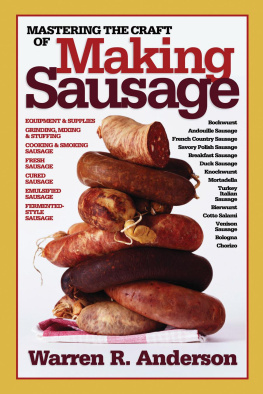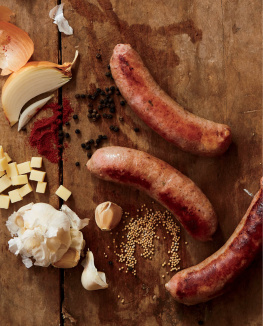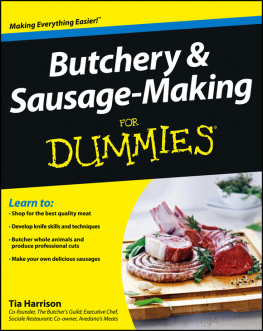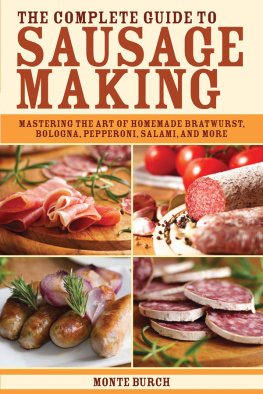Warren R. Anderson - Mastering the Craft of Making Sausage
Here you can read online Warren R. Anderson - Mastering the Craft of Making Sausage full text of the book (entire story) in english for free. Download pdf and epub, get meaning, cover and reviews about this ebook. year: 2010, publisher: Burford Books, genre: Children. Description of the work, (preface) as well as reviews are available. Best literature library LitArk.com created for fans of good reading and offers a wide selection of genres:
Romance novel
Science fiction
Adventure
Detective
Science
History
Home and family
Prose
Art
Politics
Computer
Non-fiction
Religion
Business
Children
Humor
Choose a favorite category and find really read worthwhile books. Enjoy immersion in the world of imagination, feel the emotions of the characters or learn something new for yourself, make an fascinating discovery.
- Book:Mastering the Craft of Making Sausage
- Author:
- Publisher:Burford Books
- Genre:
- Year:2010
- Rating:5 / 5
- Favourites:Add to favourites
- Your mark:
- 100
- 1
- 2
- 3
- 4
- 5
Mastering the Craft of Making Sausage: summary, description and annotation
We offer to read an annotation, description, summary or preface (depends on what the author of the book "Mastering the Craft of Making Sausage" wrote himself). If you haven't found the necessary information about the book — write in the comments, we will try to find it.
Mastering the Craft of Making Sausage — read online for free the complete book (whole text) full work
Below is the text of the book, divided by pages. System saving the place of the last page read, allows you to conveniently read the book "Mastering the Craft of Making Sausage" online for free, without having to search again every time where you left off. Put a bookmark, and you can go to the page where you finished reading at any time.
Font size:
Interval:
Bookmark:
Table of Contents


Copyright 2010 by Warren R. Anderson
All Rights Reserved. No part of this book may be reproduced in any manner without the express written consent of the publisher, except in cases of brief excerpts in critical reviews and articles. All inquiries should be addressed to: Burford Books, Inc., PO Box 388, Short Hills, NJ 07078.
Printed in the United States of America.
10 9 8 7 6 5 4 3 2 1
Library of Congress Cataloging-in-Publication Data
Anderson, Warren R., 1939
Mastering the craft of making sausage / Warren R. Anderson.
p. cm.
ISBN 978-1-58080-155-3
1. Sausages. 2. Cookery (Sausages) I. Title.
TX749.A688 2010
641.3'6dc22 2010010724
CHAPTER 1
Introduction
A Brief History of Sausage
The word sausage has a dignified and long pedigree. It originated with the Latin word salsus , which means seasoned with salt. From Latin, the word successively went into Late Latin, Old French, Middle English, and finally Modern English. At each step, the pronunciation and meaning changed a little until it became sausage , the word we use now.
When humans began applying salt to meat, the foundation for the evolution of sausage was established. At first, salt was applied to meat because it not only helped preserve it, but also made it taste better. And, because meat was precious, even the scraps were salted. Scraps of salted meat were put in whatever containers were available; eventually it was discovered that offal, such as cleaned intestines, bladders, and stomachs of the slaughtered animals made ideal containers.
It is believed that the Sumerians, living in the area that is now called Iraq, were making sausage as early as 3000 BCE. In approximately the 13th century BCE, the ancestors of the modern Chinese began using salt to preserve food. In Chinese literature dated 589 BCE, a sausage made of goat and lamb meat was mentioned. Sausages are also depicted in paintings of Chinese kitchens dated around 500 BCE. In ancient Greece, the famous poet Homer mentioned a kind of sausage made of blood in The Odyssey , and around 500 BCE, a Greek play was written entitled The Sausage . Sausage eating became so popular at Roman festivals that the conservative church banned it. Sausage has existed in the diets of cultures around the world for a very long time.
As time went on, sausage making evolved in most of the worlds cultures, particularly in those that raised domesticated animals to eat. Meat from pigs, cattle, sheep, and goats was used most often to make sausage. Native Americans, however, used wild game to make a sausage-like product called pemmi-can . The seasoning used in the various sausages was determined by availability and tradition.
Climate, too, had an influence on the kinds of sausage that evolved. In the hot Mediterranean region, dry-cured sausage requiring no refrigeration appeared. In the cooler climate of Germany, the semidry-cured sausage had a sufficiently long storage life.
The most profound changes in the taste of European sausage came with the gradual influx of exotic spices and herbs brought from the Spice Islands and other parts of Indonesia.
The pilgrims who settled in America brought with them the knowledge of sausage-making that existed in England, their mother country. Soon, they were able to get breeding stock from England, and could make sausage using pork and beef, as well as wild game. Most of the seasoning and other ingredients used in the sausage were those that were locally available, and uniquely American sausages appeared.
As America developed and expanded westward, various immigrant groups such as Germans, Italians, and Poles came to the United States to share the American dream. Most of these groups brought with them the love of sausage and, more importantly, many of them brought sausage-making skills.
Industry was rapidly developing in the large cities, and employment opportunities concentrated the immigrants there. The skilled sausage makers among them opened sausage shops, and they flourished. Some of these shops eventually grew into sausage-making companies.
With the opening of slaughterhouses and sausage shops in the large cities, sausage making was becoming more of an industrial activity than a farming activity. As such, more efficient production methods were needed. In the early 19th century, lever-operated sausage stuffers were invented. Meat choppers (grinders) were also invented; the first ones were made of hardwood, with steel blades. A hardwood box housed three hardwood gears, and the steel blades were attached to two rotating hardwood cylinders. Hunks of solid meat were put into one end of the grinder, and chopped meat came out the other end. These and other technical advances, such as refrigeration, helped mark the beginning of the sausage-making industry and the decline of sausage making at home or on the farm.
The United States sausage industry currently produces about 200 kinds of sausage, and makes more sausage than any other country in the world. In Germany, however, there are over 1,000 kinds of sausage on the retail market and the per capita consumption of sausage is much higher than the United States. If the population of Germany were the same as the United States, it would be the worlds major producer.
Homemade Sausage Today
In the history of sausage making, there has been no better time than the present to make sausage at home.
High quality fresh pork, beef, lamb, and various specialty meats used to make many of the worlds sausage varieties are easily purchased at local grocery stores. It is no longer necessary to wait for cool weather to butcher the animals and gather the scraps of meat for sausage. We can buy large primal cuts, such as a whole pork shoulder butt, and make sausage any time of the year.
When we buy our fresh, chilled meat at the grocery store, we take it home and safely store it in our refrigerator, or we can even freeze the meat if we cant get around to making the sausage soon. The refrigerator and freezer also keep wild game fresh until it is made into sausage. When meat is being processed into sausage, the refrigerator is used repeatedly to keep the raw materials cold. Nowadays, we take the refrigerator for granted, but the availability of refrigeration in our home means that we can make the sausage more leisurely. We need not worry so much about the spoilage that was so common in the old days.
In this age, there are almost no restrictions on spices and seasonings. We are not limited to items that are produced locally. Most of the flavorings we need are available at our local grocery store. Obtaining seasoning for an exotic sausage might require searching for it in ethnic grocery stores or on the Internetbut a few minutes search on the Internet will locate almost anything. In short, we can find the seasoning ingredients needed to make almost all the sausages of the world.
We no longer have to mince the meat on a chopping block with a cleaver in each handthe inexpensive hand-cranked meat grinder does a better and faster job. With a little more money, we can even buy an electric-powered one to make grinding even easier and faster.
One of the most tedious jobs in the old days was stuffing the casings by using a special handheld funnel and poking the sausage paste into the casing with a wooden dowel. The invention of several configurations of stuffers has now made sausage stuffing a task that many find pleasurable, and certainly not tedious.
With the Internet, sausage-making supplies and equipment are literally at our fingertips. No matter where we live in the world, our Internet order will be put on our doorstepif a delivery truck can reach our house.
Next pageFont size:
Interval:
Bookmark:
Similar books «Mastering the Craft of Making Sausage»
Look at similar books to Mastering the Craft of Making Sausage. We have selected literature similar in name and meaning in the hope of providing readers with more options to find new, interesting, not yet read works.
Discussion, reviews of the book Mastering the Craft of Making Sausage and just readers' own opinions. Leave your comments, write what you think about the work, its meaning or the main characters. Specify what exactly you liked and what you didn't like, and why you think so.






